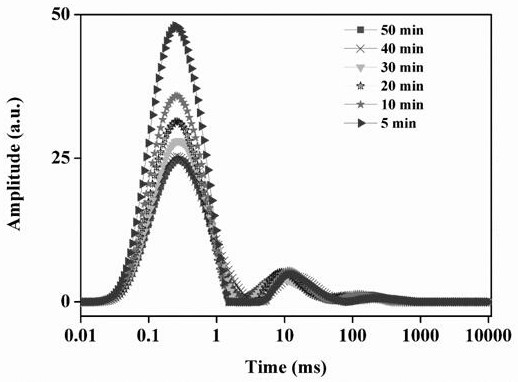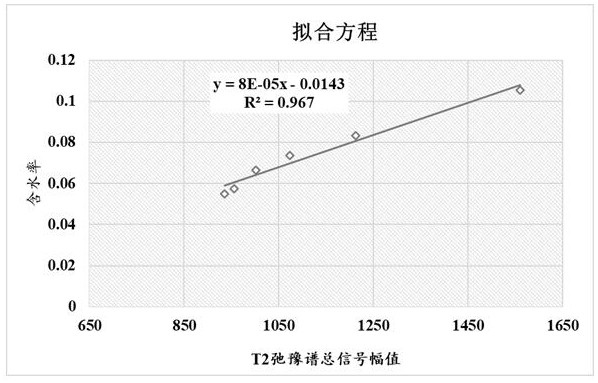Method for rapidly and nondestructively detecting moisture content and drying degree of green tea in drying process based on low-field nuclear magnetic resonance technology
A low-field nuclear magnetic resonance, drying process technology, used in the field of chemical analysis
- Summary
- Abstract
- Description
- Claims
- Application Information
AI Technical Summary
Problems solved by technology
Method used
Image
Examples
Embodiment 1
[0024] 1 Experimental part
[0025] 1.1 Instruments and devices
[0026] ME103E electronic balance, Mettler-Toledo (Shanghai) Instrument Co., Ltd.; MesoMR23-060H-I low-field nuclear magnetic resonance analyzer, Suzhou Numei Analytical Instrument Co., Ltd.; 80 type electromagnetic cleaning machine, Yuyao City Yaojiangyuan Tea Tea Machine Co., Ltd.; 6CR-55 tea rolling machine, Zhejiang Shangyang Machinery Co., Ltd.; CS-90XZ baking machine, Quanzhou Changsheng Tea Machinery Co., Ltd.
[0027] 1.2 Materials and reagents
[0028] The fresh tea leaves were collected in Shengzhou City, Zhejiang Province in April 2020. The variety is Zhongcha 108, and the tenderness ranges from one bud and one leaf to one bud and two leaves. The specific processing technology is as follows: Spreading (indoor temperature 25°C-28°C, humidity 70%-80%, moisture content down to about 70%) → drum type finishing (leaf throwing amount 150 kg / h, 260°C, 75 s, the moisture content is about 47%) → kneading (30...
Embodiment 2
[0037] Embodiment 2: detect the sample to be tested
[0038] Weigh about 1g of the tea sample to be tested (dried for 35 min at the same drying temperature of 85°C above) and put it into the magnet coil, and optimize the low-field NMR detection conditions. The specific parameters for CPMG sequence analysis are: NMR type It is a permanent magnet, the frequency of the nuclear magnetic generator is 23 MHz, 90° pulse width P1: 10μs; 180° pulse width P2: 19.52μs; receiver bandwidth SW: 333.333 KHz; time delay DL1: 0.06524ms; analog gain RG1: 20 ;Digital gain DRG1: 3, preamplifier gain PRG: 3; control parameter RFD of start sampling time: 0.08ms, delay DL1: 0.06524ms; NECH: 2000, so that the sample signal is completely relaxed; Repeated sampling waiting time TW: 1000ms; set the number of repeated sampling NS: 64, carry out NMR signal acquisition, and obtain the CPMG attenuation spectrum of the sample, and invert the measured transverse relaxation time T2 frequency image through soft...
Embodiment 3
[0041] Embodiment 3: detect the sample to be tested
[0042] Weigh about 1g of the tea sample to be tested and put it into the magnet coil, and optimize the low-field NMR detection conditions. The specific parameters for CPMG sequence analysis are: the NMR magnetic type is a permanent magnet, and the NMR generator frequency is 23 MHz, 90° Pulse width P1: 10μs; 180° pulse width P2: 19.52 μs; receiver bandwidth SW: 333.333 KHz; delay DL1: 0.06524 ms; analog gain RG1: 20; digital gain DRG1: 3, preamp gain PRG: 3; The control parameters of the start sampling time RFD: 0.08ms, delay DL1: 0.06524 ms; NECH: 2000, so that the sample signal is completely relaxed; repeated sampling waiting time TW: 1000 ms; set the number of repeated sampling NS: 64, for nuclear magnetic resonance The signal is collected to obtain the CPMG attenuation spectrum of the sample, and the measured transverse relaxation time T2 frequency image is inverted by software to obtain the inversion spectrum, and the t...
PUM
 Login to View More
Login to View More Abstract
Description
Claims
Application Information
 Login to View More
Login to View More - R&D
- Intellectual Property
- Life Sciences
- Materials
- Tech Scout
- Unparalleled Data Quality
- Higher Quality Content
- 60% Fewer Hallucinations
Browse by: Latest US Patents, China's latest patents, Technical Efficacy Thesaurus, Application Domain, Technology Topic, Popular Technical Reports.
© 2025 PatSnap. All rights reserved.Legal|Privacy policy|Modern Slavery Act Transparency Statement|Sitemap|About US| Contact US: help@patsnap.com


